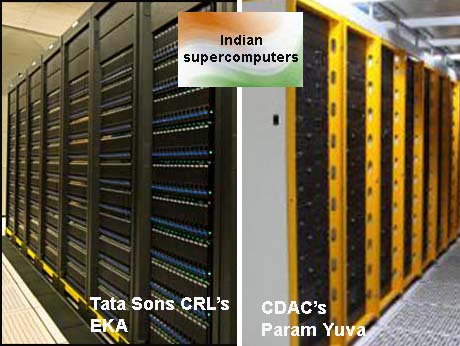
The EKA Cluster at Tata Sons Computational Research Labs, Pune remains the most powerful computer in India, clocking 132.8 teraflops ( 172 teraflops peak) and ranked number 47 in the world’s Top 500 supercomputers. The Centre of Development of Advanced Computing (CDAC)-developed Param Yuva cluster achieves a rank of 297 with a computation speed of 38.10 teraflops ( 54 teraflops peak) .
There are two other India-based imported systems in the Top 500 list: an IBM Power- based Infiniband system at no. 136 clocking 55.11 teraflops at the Indian Institute of Tropical Meteorology Pune and a HP cluster at an un-named India government institution at no. 489 achieving 31.23 teraflops.
While all these India-based machines are in the teraflop that is trillion ( ten to the 12th power) floating point operations or calculations per second, the top of the list has seven machines which have broken the peta flop barrier – that is quadrillions of calculations (a thousand trillion or ten to the 15th power).
The list is headed for the first time by a Chinese computer – the Tianhe-1A system at the National Supercomputer Center in Tianjin, achieving a performance level of 2.57 petaflop/s (or 2,570,000,000,000,000 mathematical calculations per second).
As a result, the former number one system — the Cray XT5 “Jaguar” system at the U.S. Department of Energy’s (DOE) Oak Ridge Leadership Computing Facility in Tennessee — is now ranked in second place. Jaguar achieved 1.75 petaflop/s running Linpack, the TOP500 benchmark application. Third place is now held by another Chinese system called Nebulae, located at the National Supercomputing Centre in Shenzhen, Nebulae , which performed at 1.27 petaflop/s.Tsubame 2.0 at the Tokyo Institute of Technology is number four; having achieved a performance of 1.19 petaflop/s. Tsubame is the only Japanese machine in the TOP10.At number five is Hopper, a Cray XE6 system at DOE’s National Energy Research Scientific Computing (NERSC) Center in California. Hopper just broke the petaflop/s barrier with 1.05 petaflop/s, making it the second most powerful system in the U.S. and only the third U.S. machine to achieve petaflop/s performance.
Rise of GPU The latest Top500 attests to the rise and rise of the graphical co-processing unit or GPU as a key component in high performance computing, Three of the top five computers -- numbers 1,3 and 4) are fuelled by NVIDIA’s Tesla GPUs. Graphical processors contain hundreds of parallel processor cores capable of dividing up large computational workloads and processing them simultaneously, significantly increasing system performance. Heterogeneous systems built with GPUs and CPUs require less space and consume less power, making supercomputing more affordable and more accessible.
Indeed with the graphical tail wagging the processing dog, these GPUs are being called GPGPUs -- general purpose graphical processinmg units, bidding to snatch away the traditional general processing role from central processing units or CPUs.
Another interesting trend: Of the 50 top fastest computers ranked in the bi-annual Top500 list, 24 are using an AMD CPU or GPU. The company has pioneered 64 bit computing and what is now being called heterogenous computing where a canny masala mix of cCPU and GPU delivers enhanced computational performance. Nov 17 2010
.
(details in www.top500.org )
November 17 2010